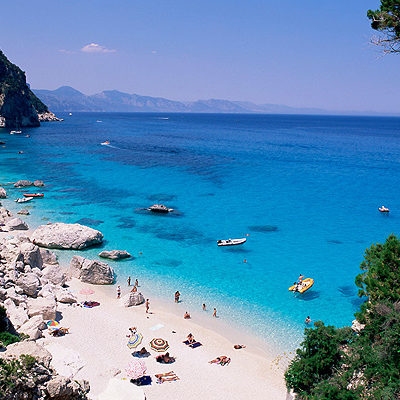ITALY – Sardinia
A yacht charter in Sardinia is quite an experience. Sardinia is a universe unto itself. I n this italian island the local language is incomprehensible to all other Italians. An island with one of Europe’s most stunning coastlines; it’s waters teem with fish; it’s golden sands disappear into oceans of blue; it’s rugged mountains are covered with flocks of sheep producing cheese so pungent, your palate will never forget.
Sardinia is completely unique and the perfect place for a yacht charter holiday that mixes excitement with the exotic. During the summer, yacht charters flock to Sardinia . With an average of 300 days of sunshine per year, concentrated from April to September and warm winds off the African continent, the Sardinian climate, can be quite delightful and not quite as hot as other yacht charter areas in the Mediterranean.
You’ll find, despite their weird and wonderful ways, that the Sardinian ports compete rather well with the Mediterranean ’s other chic hot spots. Summers tend to attract lovely warm days and crowds of millionaires, supermodels and luxury yachts, especially to the prestigious Yacht Club Costa Smeralda at Porto Cervo, near Olbia. This spectacular and unrivalled island presents a variety of shapes. In fact Sardinia is a surprising blend of “diversities” originated from its complex natural, historical and cultural richness, as it has been, since the most ancient ages, a meeting point for the various cultures of the populations which have landed on and colonized its coasts.
North Sardinia is the temple of fun. Porto Cervo and Porto Rotondo with their nightlife, chic restaurants and boutiques attract the international jet set. In the northern part of the island, between Alghero and Olbia you will also find a rich coastline alternating beaches and bays while the landscape is predominantly rocky. A fantastic journey along the northern irregular coasts of Sardinia, where nature has been wonderfully moulded by a civilization, the roots of which stretch back at the time of the first inhabitants of the Mediterranean .
Porto Cervo, the heart of the Emerald Coast , is the exclusive holiday place favoured by the rich and famous that come to this paradise to enjoy the sea and the nightlife. The architecture of this summer spot fits with its surroundings, villas with dry stone walls and immaculately kept gardens scattered with Mediterranean vegetation and low palm trees. Porto Cervo has two harbours, Porto Vecchio (Old Port) is on the South-eastern side and dates back to the 1960s’, the new harbour is equipped with the most up-to-date infrastructures to cater for the international marine traffic.
At the height of summer the harbours become literally the showroom of the most beautiful and biggest yachts that money can buy, many tourists walk past the yachts admiring such excess. Anyone not wanting to use the port may anchor in the bay, where one can enjoy total privacy. Porto Cervo has a Yacht Club, some exclusive hotels and restaurants, such as the renowned Cala di Volpe, great shops and numerous night bars and clubs. The nightlife evolves around La Piazzetta. For the golf lovers there is one of the greatest golf courts in the world. Set between the sapphire bays of Pevero and Cala di Volpe; Pevero is the supreme masterpiece of the greatest of American golf designers, Robert Trent Jones. Described by several golf writers as ‘the most beautiful place to play golf in the world’, the course is also splendidly demanding.
La Maddalena, is the most extended island and is mostly levelled. Along the southern coast lies the city of La Maddalena, delimited in the western part by the cape of Punta Tegge and in the eastern part by the ample bay of Cala Camicia and Punta Moneta; facing this bay, at a distance of 500 meters, is the island of Santo Stefano. The natural environment is still wild and its coasts shelter small beaches overlooking fabulous waters. Going north, the coastline forms the coves of Spalmatore and Porto Massimo, then the cape of Marginetto with Point Marginetto, the most northern of La Maddalena. The coast goes back down south-west, forming, with the peninsula of Abbatoggia, the deep gulf of Monti di Rena; the granite, here, is finely levigated by the violent west wind forms vast sandy dunes. You’ll find the same phenomenon going just a little further south, past Punta Abbatoggia and past the little island with the same name, in the area of Spiaggia Bassa or Trinità where the sandy landscape is even more fascinating, with its dunes of very fine white sand. The coastline continues with the steep massif of Guardia Majore, penetrating just a little further in the bay of cala Inferno, rocky and irregular; from there it goes back up west and then turnes definitely south with Punta Testiccioli. The whole area is one of the most inaccessible and the granite is marked by the sea’s fury and by the strong north winds. A good refuge is Cala Francese, just a little further south, overlooked by a large granite quarry.
Caprera island is smaller than la Maddalena but its total coastline is longer, 45,5 km, because of the long and narrow cape of granite that stretches all the way to Punta Rossa, seat of a Navy Military base since 1887. The extreme southern coast of Caprera is a morphologically very frail and unsteady area; a profound opening of the sea forms the marvellous Porto Palma. The entire eastern coast of Caprera and also the northern one, are formed by striking cliffs of granite, almost totally unaccessible, so evocative and beautiful, formed by the more steep side of the long massif of Mount Teialone.
The island of Asinara situated in the north-western part of Sardinia has an extension of 5.200 ha., while the sea’s surface extension is 21.000 ha. The coastline is 110 km.long. It belongs to the Government and is part of the territory of the town of Porto Torres. The island is 17,5 km. long and its maximum width is 6,14 km. The western part is characterized by high schistose falaises, steep rocky slopes with numerous landslides and ravines, large canals and crevices, while in the eastern part you’ll find wide bays and small beaches with the tipical rough sand of the granite morphology with ample rocky outcrops. This island is famous for its unique landscape and for the environmental beauties, but also and mostly for the rich wildlife: many are the species living on the island, some are very rare and, unfortunately threatened with extinction.
The Gulf of Angels (Golfo degli Angeli) is a splendid scenery space that appears from the sea on the south side of Sardinia limited by Pula and Nora from the west and by the seaside resorts of Villasimius on the east, through the extreme Capo Carbonara in front of which a remote and wild Isola dei Cavoli is visible.
Cagliari is the principal town, hidden like a precious jewellery in the centre of the gulf. The coasts of the Gulf form interminable beaches with thin and bright sand. Across the panoramic street with spectacular cliffs and expanses of crystal and transparent water the easter bow unties through beautiful beaches and bays of Capitana, Torre delle Stelle, Solanas, Capo Carbonara, Isola dei Cavoli. There are several sport activities from typical water sports (including diving and snorkelling) to trekking, horse riding and golf.


